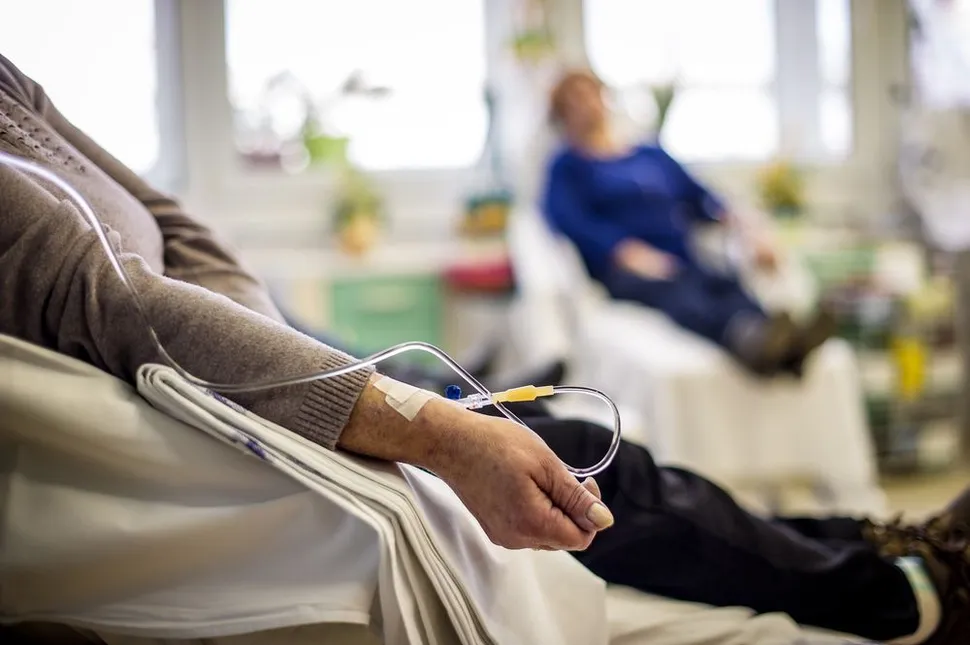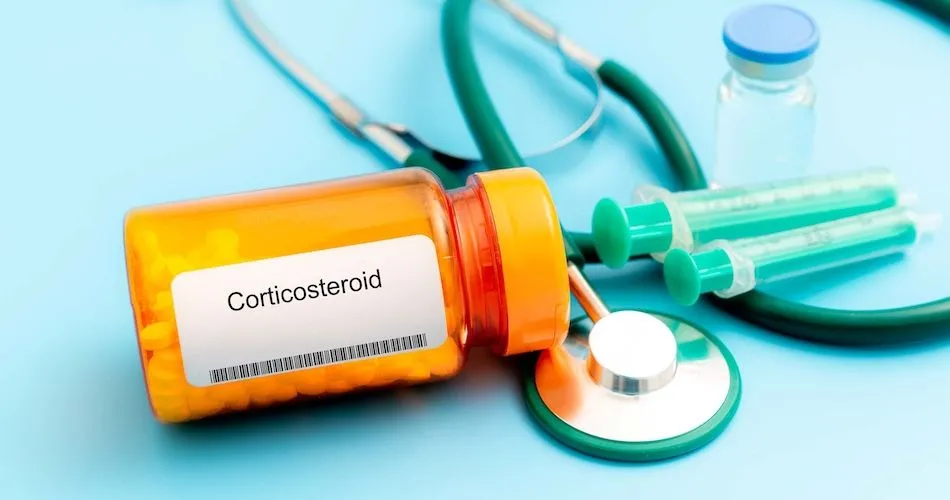What is R-CHOP?

Chemoimmunotherapy is a type of treatment often used to treat patients with lymphoma. The R-CHOP regimen is a kind of chemoimmunotherapy very used in patients with B-cell non-Hodgkin lymphomas (NHL). This is an effective regimen that cures around 60–70% of patients with diffuse large B-cell lymphoma (DLBCL).
What Does R-CHOP Mean?
R-CHOP is an acronym referring to a combination regimen that includes:
- Rituximab – a monoclonal antibody
- Cyclophosphamide – a chemotherapy drug
- Doxorubicin – a chemotherapy drug that is also known as Hydroxydaunorubicin or Adriamycin
- Vincristine – a chemotherapy drug commercialized under the name Oncovin
- Prednisone – a steroid.
How Does R-CHOP Treat Lymphoma?
The R-CHOP regimen combines rituximab, which targets CD20, a protein present on the surface of lymphoma cells, with the CHOP chemotherapy regimen to enhance its effectiveness.
Rituximab can help the immune system recognize and kill lymphoma cells. Cyclophosphamide, doxorubicin, and vincristine attack rapidly dividing cells, such as cancer cells. Prednisone inhibits the growth of cancer cells and kills them. It can also alleviate nausea during treatment and reduce the body’s immune response to prevent allergic reactions to rituximab.
What Is the Treatment Plan for R-CHOP?
The R-CHOP regimen is given in 21-day cycles. Some studies have used a 14-day cycle, but a 21-day cycle is the standard approach. The 21-day cycle typically consists of:
- Rituximab – infusion into the bloodstream over a few hours on Day 1
- Cyclophosphamide – infusion into the bloodstream or as a slow injection over around 30 minutes on Day 1
- Doxorubicin – infusion into the bloodstream or as a slow injection over around 30 minutes on Day 1
- Vincristine – infusion into the bloodstream over around 10 minutes on Day 1
- Prednisolone – orally on Days 1–5
- Followed by a rest period on Days 6–21
Patients typically receive six 21-day cycles of R-CHOP but can receive more or less depending on patient- and disease-related factors.
Older patients and/or patients with other diseases or conditions who can’t tolerate the intensive R-CHOP regimen may receive a lower dose version of R-CHOP, sometimes referred to as R-miniCHOP.
What Are the Side Effects of R-CHOP?
The side effects of R-CHOP treatment can vary from patient to patient. More than 10% of patients experienced the following side effects at varying grades of seriousness:
- Reduced white blood cells with an increased risk of infection
- Anemia and blood clots
- Physical side effects and changes: easy bruising and bleeding, hair loss, changes to nails and skin, sore mouth, weight gain, numbness or tingling in fingers or toes
- Other symptoms such as nausea and vomiting, swelling, headaches, diarrhea, constipation, fatigue, irritation of the bladder and difficulty urinating, red or pink urine, irritation of the stomach, sore mouth
- Allergic reactions during infusion, such as skin rash, itching, swelling, breathing difficulties, fever and chills
- Changes to the functioning of the heart or to the liver
- Tumor lysis syndrome, a condition that can occur after chemotherapy caused by the breakdown of cancer cells, which can result in organ damage.
Patients should contact their healthcare team if they experience:
- Severe side effects
- Persistent side effects
- Worsening side effects
If patients feel unwell during treatment, it may be a sign of an allergic reaction, and they should inform their healthcare team. If patients experience symptoms of a heart attack or blood clot, they should call emergency services.
Treatment with R-CHOP can increase your risk of infection
Due to a reduction in white blood cells during treatment, patients are more susceptible to infections, which can be serious. Contact your healthcare professionals immediately if you feel unwell or have a temperature above 99.5°F/37.5°C or below 96.8°F/36°C.
Key Takeaways
- R-CHOP is a type of chemoimmunotherapy consisting of rituximab, cyclophosphamide, doxorubicin, vincristine, and prednisolone.
- Treatment usually involves six 21-day cycles, with 5 days of treatment and 16 days of rest.
- It is important to keep your healthcare team informed about any side effects you experience.
To continue reading about treatments for DLBCL, explore all the free resources at HealthTree for DLBCL. Sign up for our newsletter and join the DLBCL community!
Sources:
Chemoimmunotherapy is a type of treatment often used to treat patients with lymphoma. The R-CHOP regimen is a kind of chemoimmunotherapy very used in patients with B-cell non-Hodgkin lymphomas (NHL). This is an effective regimen that cures around 60–70% of patients with diffuse large B-cell lymphoma (DLBCL).
What Does R-CHOP Mean?
R-CHOP is an acronym referring to a combination regimen that includes:
- Rituximab – a monoclonal antibody
- Cyclophosphamide – a chemotherapy drug
- Doxorubicin – a chemotherapy drug that is also known as Hydroxydaunorubicin or Adriamycin
- Vincristine – a chemotherapy drug commercialized under the name Oncovin
- Prednisone – a steroid.
How Does R-CHOP Treat Lymphoma?
The R-CHOP regimen combines rituximab, which targets CD20, a protein present on the surface of lymphoma cells, with the CHOP chemotherapy regimen to enhance its effectiveness.
Rituximab can help the immune system recognize and kill lymphoma cells. Cyclophosphamide, doxorubicin, and vincristine attack rapidly dividing cells, such as cancer cells. Prednisone inhibits the growth of cancer cells and kills them. It can also alleviate nausea during treatment and reduce the body’s immune response to prevent allergic reactions to rituximab.
What Is the Treatment Plan for R-CHOP?
The R-CHOP regimen is given in 21-day cycles. Some studies have used a 14-day cycle, but a 21-day cycle is the standard approach. The 21-day cycle typically consists of:
- Rituximab – infusion into the bloodstream over a few hours on Day 1
- Cyclophosphamide – infusion into the bloodstream or as a slow injection over around 30 minutes on Day 1
- Doxorubicin – infusion into the bloodstream or as a slow injection over around 30 minutes on Day 1
- Vincristine – infusion into the bloodstream over around 10 minutes on Day 1
- Prednisolone – orally on Days 1–5
- Followed by a rest period on Days 6–21
Patients typically receive six 21-day cycles of R-CHOP but can receive more or less depending on patient- and disease-related factors.
Older patients and/or patients with other diseases or conditions who can’t tolerate the intensive R-CHOP regimen may receive a lower dose version of R-CHOP, sometimes referred to as R-miniCHOP.
What Are the Side Effects of R-CHOP?
The side effects of R-CHOP treatment can vary from patient to patient. More than 10% of patients experienced the following side effects at varying grades of seriousness:
- Reduced white blood cells with an increased risk of infection
- Anemia and blood clots
- Physical side effects and changes: easy bruising and bleeding, hair loss, changes to nails and skin, sore mouth, weight gain, numbness or tingling in fingers or toes
- Other symptoms such as nausea and vomiting, swelling, headaches, diarrhea, constipation, fatigue, irritation of the bladder and difficulty urinating, red or pink urine, irritation of the stomach, sore mouth
- Allergic reactions during infusion, such as skin rash, itching, swelling, breathing difficulties, fever and chills
- Changes to the functioning of the heart or to the liver
- Tumor lysis syndrome, a condition that can occur after chemotherapy caused by the breakdown of cancer cells, which can result in organ damage.
Patients should contact their healthcare team if they experience:
- Severe side effects
- Persistent side effects
- Worsening side effects
If patients feel unwell during treatment, it may be a sign of an allergic reaction, and they should inform their healthcare team. If patients experience symptoms of a heart attack or blood clot, they should call emergency services.
Treatment with R-CHOP can increase your risk of infection
Due to a reduction in white blood cells during treatment, patients are more susceptible to infections, which can be serious. Contact your healthcare professionals immediately if you feel unwell or have a temperature above 99.5°F/37.5°C or below 96.8°F/36°C.
Key Takeaways
- R-CHOP is a type of chemoimmunotherapy consisting of rituximab, cyclophosphamide, doxorubicin, vincristine, and prednisolone.
- Treatment usually involves six 21-day cycles, with 5 days of treatment and 16 days of rest.
- It is important to keep your healthcare team informed about any side effects you experience.
To continue reading about treatments for DLBCL, explore all the free resources at HealthTree for DLBCL. Sign up for our newsletter and join the DLBCL community!
Sources:

about the author
Dylan Barrett
Dylan is a freelance medical writer based in Cork, Ireland. He previously worked in independent medical education while living in London and is now collaborating with HealthTree to develop resources for blood cancer patients. His background is in genetics, and he has a passion for innovative scientific research. In his spare time, he enjoys sports, traveling, and spending time with his family and friends.
More on Core Education
Trending Articles
Get the Latest Non-Hodgkin Lymphoma Updates, Delivered to You.
By subscribing to the HealthTree newsletter, you'll receive the latest research, treatment updates, and expert insights to help you navigate your health.
Together we care.
Together we cure.
3x Faster.









